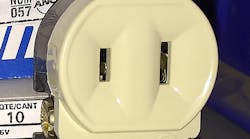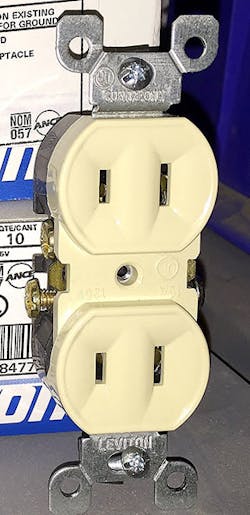All references are based on the 2017 edition of the NEC.
When you want to replace a non-grounding-type receptacle but the wiring method does not include an equipment grounding conductor (EGC), such as older NM cable with no ground wire, one option is to replace the receptacle with another non-grounding-type receptacle, as permitted by Sec. 406.4(D)(2)(a). However, many customers would prefer to have a 3-pronged grounding-type receptacle instead of the 2-pronged type. In this case, you have two other options.
Section 406.4(D)(2)(b) permits a non-grounding-type receptacle to be replaced with a GFCI-type receptacle. The receptacle or the cover plate must then be marked “No Equipment Ground.” Short of rewiring the circuit, this is a nice compromise and makes good sense. The last sentence of that Section states, “An equipment grounding conductor shall not be connected from the GFCI type receptacle to any outlet supplied from the GFCI receptacle.”
Let’s talk about this last sentence for a moment. Does it make any sense to you? Remember the wiring method supplying power to the receptacle is a 2-wire, NM type cable with no equipment ground wire. What could this last sentence be referring to then? I believe it is referring to a wire that would typically be used for equipment grounding, such as the bare wire in a newer NM cable with ground where it was installed from the receptacle to supply other existing outlets on the branch circuit. In this case, however, the bare wire inside the NM cable literally does not meet the definition of an equipment ground wire in Art. 100, since it doesn’t provide a path for fault current and has no connection to earth or the grounded conductor. Yet, I believe the intent of the wording should be applied to that bare wire in the cable.
If this bare wire were to come in contact with the energized “hot” conductor, it could energize all the metal parts of boxes, luminaires, and any other non-current-carrying metal parts connected to this wire. The GFCI would not provide protection if the bare wire was accidentally touching the line side terminals of the GFCI receptacle. This same logic should also be applied to the last sentence in Sec. 406.4(D)(2)(c) when non-grounding-type receptacles are replaced with grounding-type receptacles that are supplied through a GFCI device.
Major Code revisions for equipment grounding requirements of branch circuits and receptacles were made during the 1960s, so you are most likely to encounter these situations in homes wired during and prior to this era.





